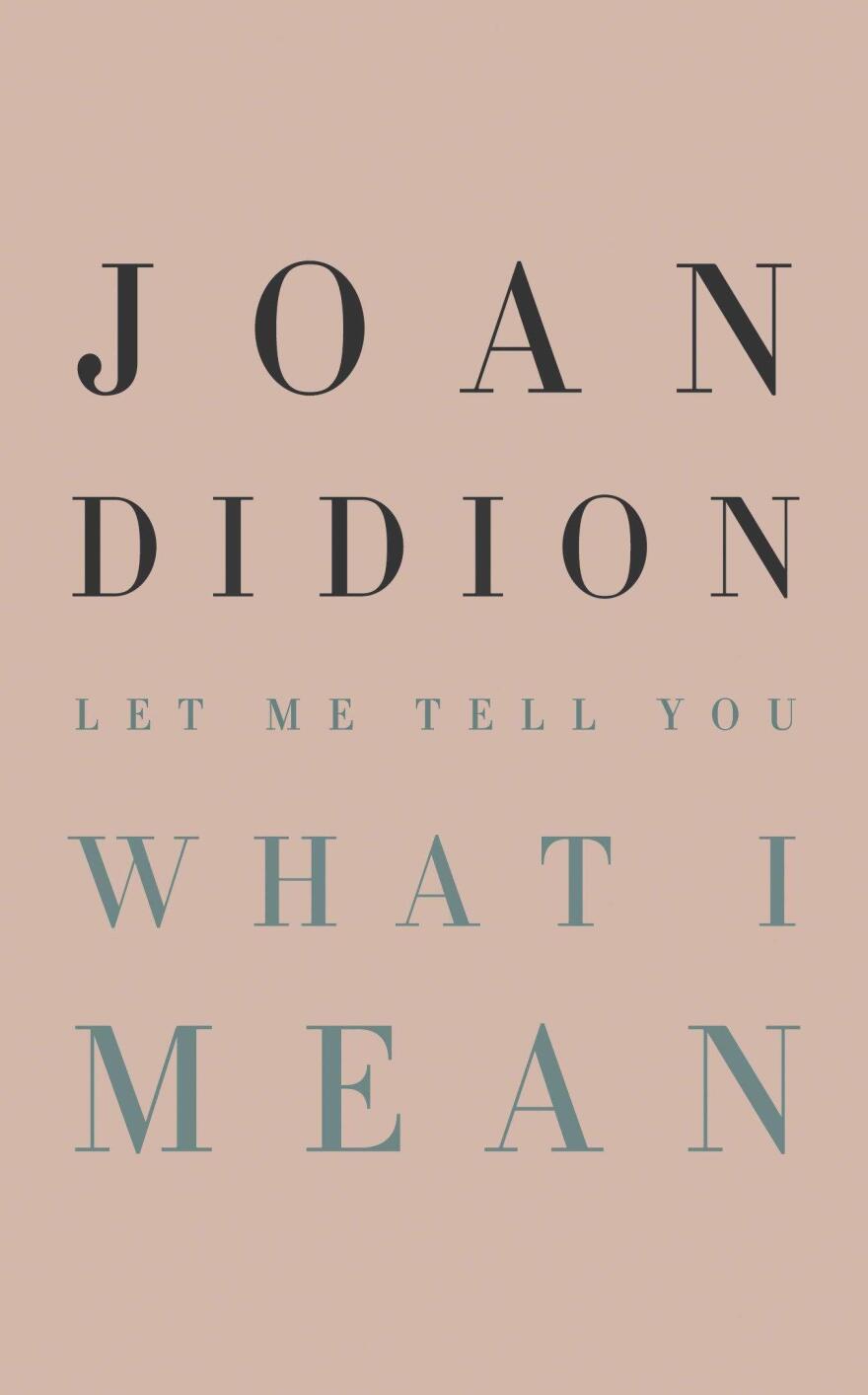In The Center Will Not Hold, the 2017 documentary about Joan Didion directed by her nephew Griffin Dunne, he asks what she felt when she saw a 5-year-old tripping on LSD while reporting from Haight-Ashbury for her 1967 essay, "Slouching Towards Bethlehem."
The automatic response from most people might be, "I was horrified." But Didion, of course, is not most people. Her answer is chilling: "Well, let me tell you, it was gold...You live for moments like that if you're doing a piece, good or bad."
There's plenty of journalistic gold in Let Me Tell You What I Mean, Didion's new book of 12 previously uncollected essays. What's particularly salient is her trademark farsightedness, which is especially striking decades later. Half the pieces date from 1968 and first appeared in the Saturday Evening Post. The most recent was written in 2000.
The opening essay, "Alicia and the Underground Press," flags "the inability of all of us to speak to one another in any direct way, the failure of American newspapers to 'get through.'" One of the things Didion appreciates about papers like the East Village Other and the Los Angeles Free Press is that they don't even make a pretense of objectivity: "When a writer for an underground paper approves or disapproves of something, he says so, quite often in lieu of who, what, where, when, how," she writes. She points out that these publications are often "strident and brash," and then adds, "But to think that these papers are read for 'facts' is to misapprehend their appeal. It is the genius of these papers that they talk directly to their readers." More than 50 years after she wrote these words, the relevance of her observations in today's fractured world of fringe media is uncannily prescient.
Another bravura performance is Didion's profile of Martha Stewart, "Everywoman.com," first published in The New Yorker in 2000. As as she sees it, Stewart's genius was in branding herself "not as a Superwoman but as Everywoman," playing into women's dreams and fantasies of "getting out of the house with a vengeance, and on your own terms." On the eve of the IPO of Martha Stewart Living Omnimedia LLC, Didion quotes from the Risk Factors section of its prospectus, which is even more devastating in hindsight:
"Our business would be adversely affected if Martha Stewart's public image or reputation were to be tarnished...Our continued success and the value of our brand name therefore depends, to a large degree, on the reputation of Martha Stewart."
Didion's profile was published four years before Stewart was sent to prison after being found guilty of felony charges of conspiracy, perjury and obstruction of justice.
Unfortunately, "Everywoman.com," like the other essays collected in Let Me Tell You What I Mean,is not accompanied by an update or further comment from Didion.You could argue that the pieces speak for themselves. Hilton Als' smart foreword offers a welcome overview, though readers who want to encounter her writing fresh, without an intermediary, might want to read it after the essays.
Several of the pieces, including "Why I Write" and "Telling Stories," address Didion's development as a writer, from honing her craft by turning out crisp copy for Voguein the 1950s ("not unlike training with the Rockettes") to learning to use the first person. "I wanted not a window on the world but the world itself," she writes of her preference for novels over short stories, and explains, "I write entirely to find out what I'm thinking, what I'm looking at, what I see and what it means. What I want and what I fear."
Readers, and especially aspiring writers, will find the rejection letters garnered by Didion's last stab at short fiction fascinating, while college applicants should find consolation in "On Being Unchosen by the College of One's Choice." In revisiting her rejection for admission to Stanford back in 1952, Didion notes that Berkeley "worked out all right" in the end. Her essay ought to be reprinted yearly for each fresh crop of college aspirants and their over-eager parents. Writing in 1968, Didion observes — long before the recent scandalous cases of parents caught willing to do anything to game the system — that compared to when she received her rejection, "Getting into college has become an ugly business."
"Last Words," Didion's tribute to Ernest Hemingway, which first appeared in The New Yorker in 1998, is another standout. Her careful analysis of the "liturgical cadence" and "tension of withheld information" in the 126-word first paragraph of A Farewell to Arms is a marvel of close reading. Her appreciation says as much about her own work as about Hemingway's: "The very grammar of a Hemingway sentence dictated, or was dictated by, a certain way of looking at the world, a way of looking but not joining, a way of moving through but not attaching," she writes with palpable admiration.
As these essays demonstrate, Didion, even with her famous detachment, is no slouch at showing us what she means. But however welcome, there's a wistfulness to this book, for it is impossible to read without wishing Didion were weighing in on how the center still cannot hold and things continue to fall apart in the 21st century.
Copyright 2021 NPR. To see more, visit https://www.npr.org. 9(MDAxODc1NzUzMDEyMTgyMjc0NzUxZmVhMQ004))



